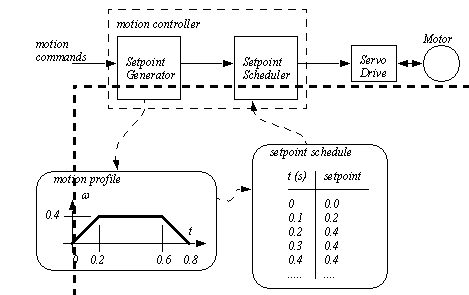
A system with a feedback controller will attempt to drive the system to a state described by the desired input, such as a velocity. In earlier chapters we simply chose step inputs, ramp inputs and other simple inputs to determine the system response. In practical applications this setpoint needs to be generated automatically. A simple motion control system is used to generate setpoints over time.
An example of a motion control system is shown in Figure 1.76 A motion controller. The motion controller will accept commands or other inputs to generate a motion profile using parameters such as distance to move, maximum acceleration and maximum velocity. The motion profile is then used to generate a set of setpoints, and times they should be output. The setpoint scheduler will then use a real-time clock to output these setpoints to the motor drive.

The combination of a motion controller, drive and actuator is called an axis. When there is more than one drive and actuator the system is said to have multiple axes. Complex motion control systems such as computer controlled milling machines (CNC) and robots have 3 to 6 axes which must be moved in coordination.